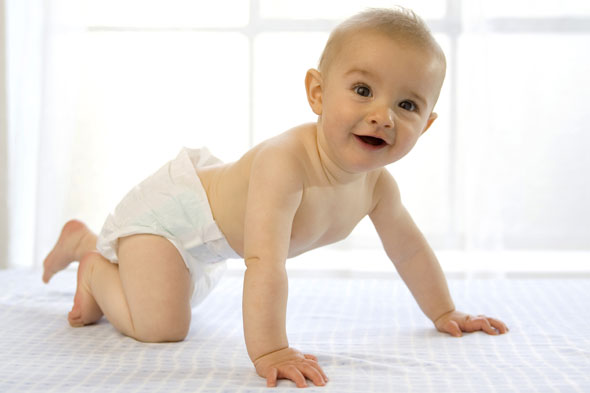 On average, babies start crawling at around eight months old, although many get moving even earlier.
On average, babies start crawling at around eight months old, although many get moving even earlier.
A crawling baby will soon start pulling up, too, which means chairs, tables, and other surfaces are no longer beyond reach.
Here are a few things to think about when childproofing your home before your little one starts crawling around.
Get crawling
The most effective way to ensure your baby's safety is to take a baby's-eye view of your home. Get down on your hands and knees and see how things look from down there. What's within reach? What looks tempting? Where would you go if you could crawl, toddle, or walk?
Install gates
Most parents consider safety gates essential childproofing tools. They allow you to open outside doors for air while keeping your child indoors, they contain him or her within a room, and they block your little one’s access to dangerous stairways and forbidden rooms (such as the bathroom or kitchen). In general, look for gates that your child can't dislodge but that you can easily open and close.
Mind for harmful substances
Store poisonous products out of your child's reach. Put safety locks on all cabinets and drawers that hold bug sprays, cleaning products, medications, and other potential poisons.
Store poisonous products out of your child's reach. Put safety locks on all cabinets and drawers that hold bug sprays, cleaning products, medications, and other potential poisons.
Protect outlets
It's a good idea to protect electrical outlets with outlet covers. Unfortunately, the removable little plug-in caps can easily end up in your baby's mouth. Instead, replace the outlet covers themselves, at least those your baby could remove, with ones that include a sliding safety latch. If you're using extension cords in your home, cover any exposed outlets with electrical tape.
Secure heavy furniture
Secure heavy furniture
Large or heavy bookcases, dressers, and appliances are real hazards. Bolt whatever you can to the wall. Push items like televisions back from the edge of the furniture they're on or move them out of reach, and then secure them, too. Always put heavier items on bottom shelves and in bottom drawers to make furniture less top-heavy.
Check ties on blinds and curtains
Window blinds pose a particular danger because a baby's neck could become trapped in the cords that raise the blinds or run through the slats. A child can become entangled in a looped window cord and strangle in a matter of minutes. Use cordless window coverings wherever possible, and avoid placing your baby's crib near a window. If you have curtains with pull cords in your home, either cut off the pull cords or use cord shorteners or wind-ups to keep them out of reach.
Secure your windows and doors
Always open double-hung windows from the top or fit them with locks to prevent small children from opening them. Low windows shouldn't open more than four inches. Window stops are available that can prevent windows from opening more than this. To make windows safe, install window stops or window guards, which screw into the side of a window frame, have bars no more than four inches apart, and can be adjusted to fit windows of many different sizes.
Prevent drowning
Prevent drowning
Tubs, toilets, and even buckets of water are all potential dangers. That's why it's important to practice water safety at home. Never leave your baby unattended in the tub - even if he or she is in a ring or bath seat. Supervise your child whenever he or she is in the bathroom, and install a safety latch on your toilet lid to prevent them from accidentally falling in.





